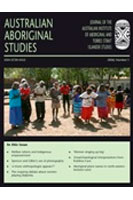Australian Aboriginal Studies: Issue 1, 2006
Abstracts for Issue 1, 2006
Welfare reform and Indigenous empowerment
Nerelle Poroch
The Prime Minister’s Indigenous welfare reform is manifold. It has introduced Shared Responsibility Agreements and Regional Partnership Agreements for Indigenous communities, and restructured the Community Development Employment Projects scheme. It has abolished the Aboriginal and Torres Strait Islander Commission and distributed its functions between mainstream government departments. Indigenous Australians are categorised as marginal, non-institutionalised and illegitimate political minorities. In effect, the government has muted the Indigenous voice from a perspective of blaming the victim, as opposed to viewing the issue within power and inequality in the distribution of resources.
The push to treat unequal Indigenous Australians equally by mainstreaming government services is in direct contrast to the United States and Canadian experiences where the degree of self-government that Indigenous nations exercise determines the change in rates of disadvantage. Ideas of empowerment through tactical intervention and emancipatory vision substantiate the overseas experience. These ideas provide an insight into ways of fostering an understanding and acknowledgment of human authenticity. They present an alternative pattern of intercultural communication where Indigenous issues set the context of government policy making in an environment of recognition of Indigenous experiences.
Visual knowledge: Spencer and Gillen’s use of photography in The Native Tribes of Central Australia
Nicolas Peterson
The native tribes of Central Australia, published in 1899, was by far and away the best photographically illustrated ethnography up to that time. It has been suggested that Spencer and Gillen relied on photography because of the practical difficulty they had in communicating with the Arrernte and in understanding what was going on. Here it is argued that the involvement with photography arose out of the intersection of the limits that face verbal communication when in the presence of complex performance, and the significance of visual information within the emerging natural-science fieldwork orientation. However, it seems that Spencer and Gillen’s intellectual understandings of Arrernte life and culture were challenged by the photographs, leading them to deny aspects of the evidence the photographs provided.
‘a triune anthropologist appears’?: Gerhardt Laves, Ralph Piddington and Marjorie Piddington, La Grange Bay, 1930
Geoffrey Gray
In April 1930 Ralph O’Reilly Piddington, his new wife Marjorie (née Barnes), and the American linguist Gerhardt Laves left Sydney for their first fieldwork in north-western Western Australia. Piddington had recently completed his bachelors degree in psychology and anthropology, Marjorie had suspended her studies. Laves, from Chicago University and a student of the famed North American linguist Edward Sapir, had been especially recruited by AR Radcliffe-Brown, the Foundation Professor of Anthropology in the University of Sydney. Their destination was La Grange, at that point well known to anthropologists from Sydney, both AP Elkin and the racial psychologist SD Porteus having worked there. The trip to Perth was via the transcontinental rail line and then by boat and truck. It was a journey not only to find a niche in the new discipline of social anthropology but also to possibly make a career, in linguistics for Laves, and psychology and social anthropology for Ralph Piddington. It is unclear what scholarly ambitions Marjorie harboured at the time. It was a journey that established and directed their future careers, although at the time they were joyfully unaware of the consequences, both professionally and personally, of this expedition.
The ongoing debate about women playing didjeridu: how a musical icon can become an instrument of remembering and forgetting
Karl Neuenfeldt
An ongoing debate surrounding the use of the didjeridu is the appropriateness of women playing it. This article explores examples of the quite diverse public discourse on the didjeridu in Australia (and elsewhere) but also some of the paradoxes informing the debate. The debate is characterised herein as part of a broader process of the construction of social memory via what is remembered or forgotten when the didjeridu is discussed or used. It is argued that, although gender is one dimension of the debate, there are other pertinent issues that need to be recognised as pivotal.
‘Women singing up big’: the growth of contemporary music recordings by Indigenous Australian women artists
Katelyn Barney
Since the 1980s, the number of recordings made by Indigenous Australian performers has grown and those by Indigenous Australian women particularly have increased in the last 16 years. While scholars have examined the factors for the increase of recordings made by Indigenous performers generally, critical literature focusing on the continuing growth of recording output by Indigenous women performers is limited. Drawing on two discographies I have compiled of commercial recordings by Indigenous women performers, I examine the possible factors contributing to the growth of recordings by Indigenous women artists since 1990. I also examine some issues regarding gender and music and the social and political contexts relating to the recording output of Indigenous Australian women.
